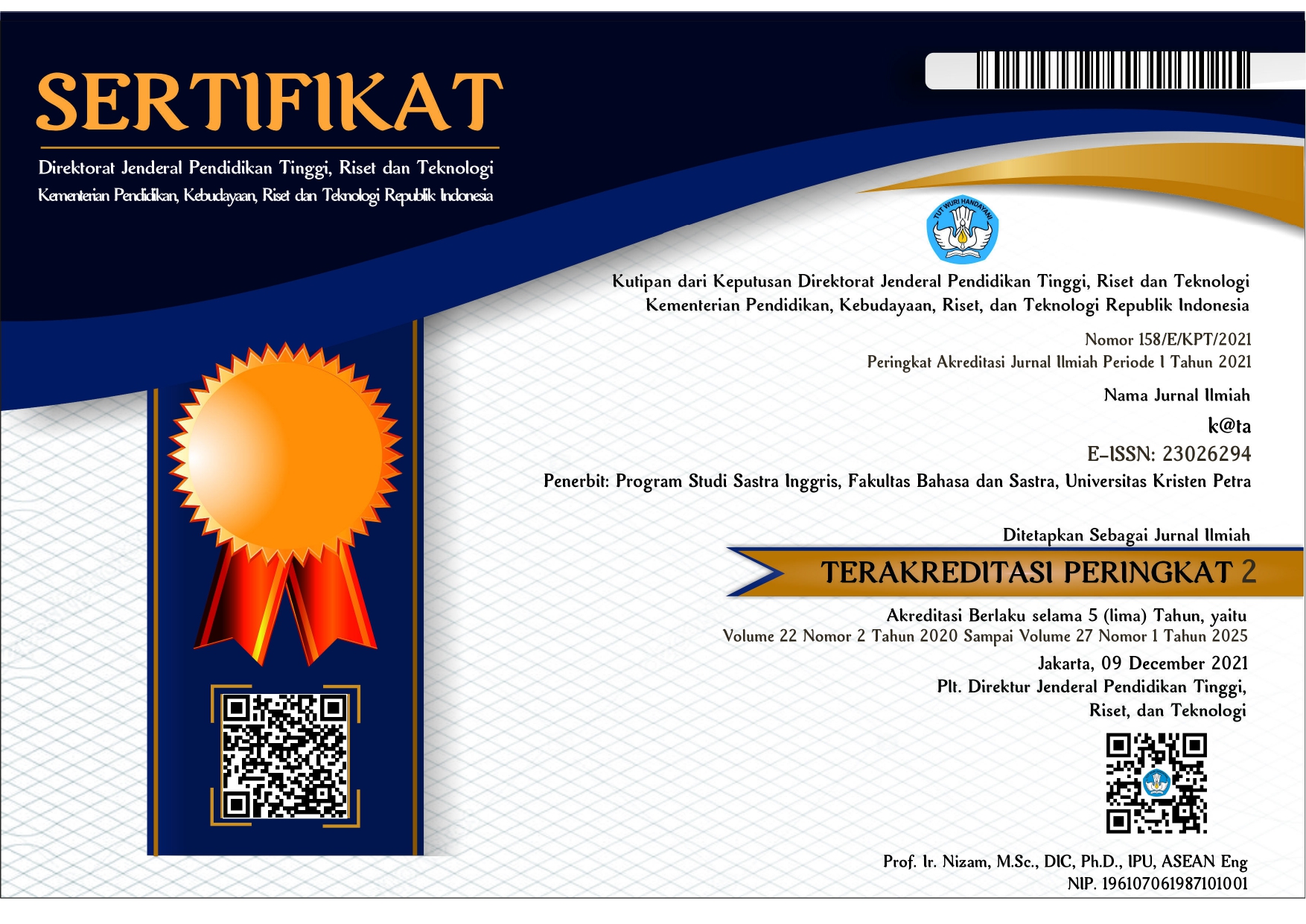Cross-Cultural Imagination: Survival and Harmony in Nalo Hopkinson's Brown Girl in the Ring
DOI:
https://doi.org/10.9744/kata.27.1.67-79Keywords:
Nalo Hopkinson, Brown Girl in the Ring, Cross-cultural imagination, Afro-Caribbean LiteratureAbstract
This paper analyzes Hopkinson’s Brown Girl in the Ring (1998) through Harris’s (1983) concept of cross-cultural imagination, which envisions cultural hybridity as a path to healing and coexisting instead of effacement. By focusing on the novel's protagonist, Ti-Jeanne, the paper examines how spirituality and Caribbean mythology guide her in reconnecting with her Afro-Caribbean heritage within a dystopian Toronto setting. Through Harris’s (1983) lens, Ti-Jeanne’s identity conflict is resolved by embracing both cultures as a means to empower herself and her community. The paper examines whether one can coexist harmoniously with a new culture or if abandoning one's background is the only path to adaptation. Ultimately, the novel suggests that exploring diverse cultures is not just an academic exercise but a transformative process—one that fosters healing, reshapes societies, and cultivates mutual respect.
Downloads
References
Ančić, N. (2009). Dystopian future and mythical past in Nalo Hopkinson’s novels Brown Girl in the Ring and Midnight Robber. In J. Novaković & B. Dojčinović-Nešić (Eds.), Culture and ideology: Canadian perspectives (pp. 149-156). Faculty of Philology of Belgrade.
Bedford, A. (2018). Ecofeminist, postcolonial, and anti-capitalist possibilities in Nalo Hopkinson’s Brown Girl in the Ring. In S. Mickey & D. A. Vakoch (Eds.), Ecofeminism in dialogue (pp. 15-30). Lexington Books.
Bustamante, E. C. (2007). Fragments and crossroads in Nalo Hopkinson's Brown Girl in the Ring. Spaces of Utopia: An Electronic Journal, 4(Spring 2007), 11-30. https://ojs.letras.up.pt/index.php/sput/article/download/12171/11068
Chakravorty, M. (2015). Of dystopias and deliriums: The millennial novel in India. In Anjaria, U. (Ed.), A history of the Indian novel in English (pp. 267-281). Cambridge University Press. https://doi.org/10.1017/CBO9781139942355.018
Coleman, M. A. (2009). Serving the spirits: The Pan-Caribbean African-derived religion in Nalo Hopkinson's Brown Girl in the Ring. Journal of Caribbean Literatures, 6(1), 1-13. http://www.jstor.org/stable/40986295
D’Aguiar, F. (2003, January 1). Interview: Wilson Harris by Fred D’Aguiar. BOMB Magazine. https://bombmagazine.org/articles/2003/01/01/wilson-harris/
Dimkpa, P. (2015). Colonialism, independence and underdevelopment in Africa: The pre-eminence and blame game [Master's thesis, Dalarna University]. DiVA Portal. https://www.diva-portal.org/smash/get/diva2:1386410/FULLTEXT01.pdf
Gartner, L. (2021). Intersectionality and empathy in Afrofuturist feminist dystopian narratives: Octavia Butler’s Parable of the Sower and Nalo Hopkinson’s Brown Girl in the Ring. (2021). MacEwan University Student eJournal, 5(1), 1–9. https://doi.org/10.31542/muse.v5i1.2005
Glassman, M. (1989). Interview with Wilson Harris. Border/Lines, 15, 25-27. https://journals.lib.unb.ca/index.php/bl/article/view/24843
Glave, D. D. (2003). An interview with Nalo Hopkinson. Callaloo, 26(1), 146–159. https://doi.org/10.1353/cal.2003.0012
Harris, W. (1983). The womb of space: The cross-cultural imagination. Praeger.
Harris, W. (1999). Cross-cultural community and the womb of space. In A. J. M. Bundy. (Ed.), Selected essays of Wilson Harris (pp. 65–128). Routledge. https://doi.org/10.4324/9780203981832
Hopkinson, N. (1998). Brown girl in the ring. Warner Books.
Lalbakhsh, P., Khoshnood, A., & Gholami, F. (2015). Juxtaposition of women, culture, and nature in Alice Walker's Possessing the Secret of Joy. k@ta, 16(2), 93–100. https://doi.org/10.9744/kata.16.2.93-100
McCormack, D. (2016). Living with others inside the self: Decolonising transplantation, selfhood and the body politic in Nalo Hopkinson’s Brown Girl in the Ring. Medical Humanities, 42(4), 252–258. https://doi.org/10.1136/medhum-2016-010917
Mohammed, M. A. (2020). N. Scott Momaday's style in House Made of Dawn. Journal of Surra Man Raa, 16(63), 937–966.
Mohammed, M. A., & Abd Alhadi, M. H. (2020). Child narration in Harper Lee's To Kill a Mockingbird. Koya University Journal of Humanities and Social Sciences, 3(1), 150–155. https://doi.org/10.14500/kujhss.v3n1y2020.pp150-155
Mohanraj, A. M. (2000). Interview: Nalo Hopkinson In I. Lavender III (Ed.), Conversations with Nalo Hopkinson (pp. 30-36). University Press of Mississippi.
Moore, B. L., & Johnson, M. A. (2004). Neither led nor driven: Contesting British cultural imperialism in Jamaica, 1865-1920. University of the West Indies Press.
Olmos, M. F., & Paravisini-Gebert, L. (2003). Creole religions of the Caribbean: An introduction from Vodou and Santería to Obeah and Espiritismo. NYU Press.
Panda, A. (2023). The changing face of dystopia: A comparative study of literature in the 20th and 21st centuries. Educational Administration: Theory and Practice, 29(4), 1079-1086. https://doi.org/10.53555/kuey.v29i4.6234
Paton, D. (2019, June 16). The racist history of Jamaica’s Obeah act. Jamaica Gleaner. https://jamaica-gleaner.com/article/news/20190616/diana-paton-racist-history-jamaicas-obeah-act
Roberts, D. E. (1997). Unshackling black motherhood. Michigan Law Review, 95(4), 938-964. https://doi.org/10.2307/1290050
Rutledge, E. G. (1999). Speaking in tongues: An interview with science fiction writer Nalo Hopkinson. In I. Lavender III. (Ed.), Conversations with Nalo Hopkinson (pp. 12-29). University Press of Mississippi.
Salvini, L. (2012). A heart of kindness: Nalo Hopkinson's Brown Girl in the Ring. Journal of Haitian Studies, 18(2), 180-193. http://www.jstor.org/stable/41949211
Sejpal, A. (2017). Waving at trains: An interview with Nalo Hopkinson. In I. Lavender III. (Ed.), Conversations with Nalo Hopkinson (pp. 216-223). University Press of Mississippi.
Wilby, L. (2021). Posthumanism and black studies in Nalo Hopkinson’s Brown Girl in the Ring. Ariel: A Review of International English Literature, 52(1), 1-32. https://doi.org/10.1353/ari.2021.0000
Wolff, C. (2001). An interview with Nalo Hopkinson. In I. Lavender III. (Ed.), Conversations with Nalo Hopkinson (pp. 37-45). University Press of Mississippi.
Downloads
Published
How to Cite
Issue
Section
License
Copyright (c) 2025 Mushtaq Abdulhaleem Mohammed Fattah, Ola Ahmed AL- Ajeeli

This work is licensed under a Creative Commons Attribution 4.0 International License.
![]() This work is licensed under a Creative Commons Attribution License
This work is licensed under a Creative Commons Attribution License



.png)
.png)

















